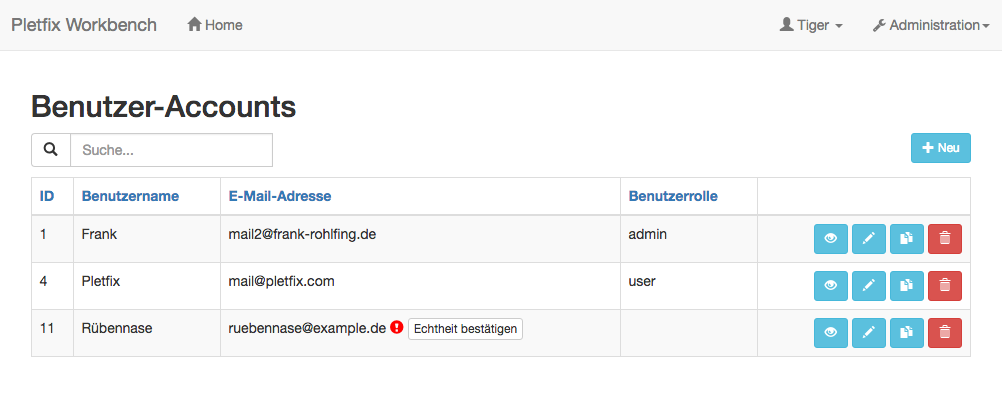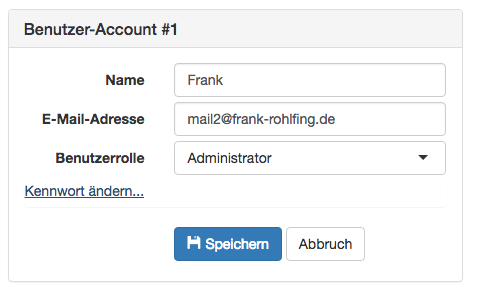pletfix / auth-plugin
Authentication Plugin for Pletfix
Installs: 8
Dependents: 0
Suggesters: 0
Security: 0
Stars: 1
Watchers: 1
Forks: 0
Open Issues: 0
Language:HTML
pkg:composer/pletfix/auth-plugin
Requires
- php: >=5.6.4
This package is not auto-updated.
Last update: 2025-12-21 09:35:34 UTC
README
About This
This plugin provides forms that allow the user to register via Double opt-in process and to log in. The user can also reset or change their password. In addition, the plugin provides the "remember-me" functionality.
Furthermore, the plugin contains a simple administration frontend to manage the user accounts.
It assumes that the default user model from the Pletfix Application Skeleton is used to store the user attributes.
Installation
Fetch the package by running the following terminal command under the application's directory:
composer require pletfix/auth-plugin
After downloading, enter this command in your terminal to register the plugin:
php console plugin pletfix/auth-plugin
Execute the migrate command to create a password_resetsdatabase table:
php console migrate
Customize
View
If you would like to modified the views of the plugin, create a folder auth under the view directory of the application,
and copy the views there. Here you can edit the views as you like:
mkdir ./resources/views/auth
cp -R ./vendor/pletfix/auth-plugin/views/* ./resources/views/
If you have installed the Pletfix Application Skeleton, you could add the necessary
menu items ("login", "logout", "register" and so on) by including the partial _nav in your
resources/views/app.blade.php layout just above the marker {{--menu_point--}}:
@include('auth._nav')
Abilities
Add the manage-userability to the Access Control List in config/auth.php to control the access to the
user management frontend:
'acl' => [
//...
'manage-user' => ['admin'],
],
Routes
If you don't use the manage-userability, or if you like to use another route paths, copy the route entries from
./vendor/pletfix/auth-plugin/boot/routes.php into the application's routing file ./boot/routes.php, where
you can modify them as you wish:
// Registration Routes
$route->get('auth/register', 'RegistrationController@showForm');
$route->post('auth/register', 'RegistrationController@register');
$route->get('auth/register/{token}', 'RegistrationController@confirm');
$route->get('auth/register/resend', 'RegistrationController@resend', 'Auth');
// Authentication Routes
$route->get('auth/login', 'LoginController@showForm');
$route->post('auth/login', 'LoginController@login');
$route->post('auth/logout', 'LoginController@logout', 'Auth');
// Password Reset Routes
$route->get('auth/reset', 'PasswordResetController@showForgotForm');
$route->post('auth/reset/send', 'PasswordResetController@send');
$route->get('auth/reset/{token}', 'PasswordResetController@showResetForm');
$route->post('auth/reset', 'PasswordResetController@reset');
// Password Change Routes
$route->middleware('Auth', function(Route $route) {
$route->get('auth/password', 'PasswordChangeController@showForm');
$route->post('auth/password', 'PasswordChangeController@change');
});
// User Management Routes
$route->middleware('Ability:manage-user', function(Route $route) {
$route->get('auth/users/{user}/replicate', 'UserManagerController@replicate');
$route->get('auth/users/{user}/confirm', 'UserManagerController@confirm');
$route->resource('auth/users', 'UserManagerController');
});
Basic Authentication
As an alternative to the default login form you can use HTML Basic Authentication. In this case the action method
LoginController@basicAuth must be called instead of LoginController@showForm if the login route is requested.
To do this, add the following route entry into ./boot/routes. php:
$route->get('auth/login', 'LoginController@basicAuth');
Of course, you can also create a new route so that the previous login form is still accessible:
$route->get('auth/basic', 'LoginController@basicAuth');
Usage
Registration
Enter the following URL into your Browser to open the registration form:
https://<your-application>/auth/register
After the user submitted the form, a new entity is saved into the user model (with a "guest" role) so that the user is log in into the application immediately (but only as a guest).
A mail is sent to the email address the user has entered.
While the user is logged in, he may resend the mail by entering this URL:
https://<your-application>/auth/register/resend
If the user confirms the email, their role is updated to "user" and a confirmation message is printed:
Login and Logout
The URLs to login into the application is this:
https://<your-application>/auth/login
If the user ticks "remember-me", a long life (5 years) cookie is created on the browser. If the PHP session expires (because has close the browser and opens it later for example), the User will be re-login automaticaly.
Of course, you could logout by entering this URL:
https://<your-application>/auth/logout
The logout method kill the authentication data and - additional - the "remember-me" cookie if exist.
Reset Password
To reset the password, two forms are needed. Enter this to start the reset process:
https://<your-application>/auth/reset
After submit a random token is saved into the password_resets database table and a mail is send to this email address.
If the user confirms the email, the token will be matched and the second form to receive the new password is opened:
Change Password
The user may change their password quickly if already log in:
https://<your-application>/auth/reset
User Management Frontend
Enter the following URL into your Browser to open the user management:
https://<your-application>/auth/users










